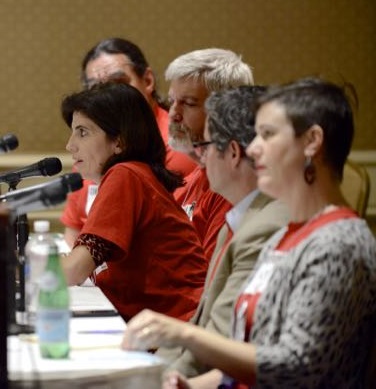If you’ve ever been to an Oral History Association meeting, you’ll know there’s really only one theme: What is oral history?
That’s what Stephen Sloan, OHA past president and director of Baylor University’s Institute for Oral History, told an OHA plenary session—and he was only partly joking.
He and four other panelists at the Thursday afternoon session pinpointed key developments in oral history in the past half-century and sparked lively discussion from the audience.
Amy Starecheski, co-director of the Oral History M.A. Program at Columbia University, noted that unlike prevailing conditions in the academy at the time of the first oral history colloquium, today’s oral historians typically no longer have to fight for legitimacy. She pointed to the growth and democratization of the field and noted a surge of interest in using oral history for social justice.
OHA past president Paul Ortiz, director of the Samuel Proctor Oral History Program at the University of Florida, echoed Starecheski’s observations about the role of social justice and social change as elements of oral history. Oral history took off as a discipline in the 1960s during a time of social crisis and social change, he said, with oral historians uniquely positioned to help people tell their stories and bridge differences.
Natalie Fousekis, newly elected OHA first vice president and director of the Center for Oral and Public History at California State University, Fullerton, highlighted the role of feminist thought in the evolution of oral history practice. Oral history interviews, she said, allow women—and all interviewees—to interpret their own lives and experiences. But she noted a growing dilemma oral historians face in recording in-depth, lengthy interviews while at the same time emphasizing a desire for greater access to those interviews.
Sloan noted that the past half-century in oral history has been driven by changes in technology and by the “big-tent-ness” of oral historians making room for various practitioners motivated by a “desire to do something.”
“Good oral history,” Sloan said, “has always been about crisis.”
Doug Boyd, who took the helm as OHA’s new president, said his interest in oral history has been shaped by frustration over lack of use of archival collections. Without access, oral histories only have potential impact, he said.
Boyd, who directs the University of Kentucky Libraries’ Louie B. Nunn Center for Oral History, spearheaded creation of the Oral History Metadata Synchronizer (OHMS), an open-source, web-based application that allows users to quickly search oral history interviews online.
But greater online access to interview content has created a “new frontier” for oral history, he said, creating challenges to the privacy of oral history content and raising the bar for informed consent.
Boyd called it challenging to try to anonymize interviews by stripping out identifying information. A good life history interview includes extensive personal information, he noted, enough so that an unscrupulous reader could use that information to create phony bank accounts.
“There was a safety in archival security,” he said, suggesting that oral historians should consider focusing on doing better interviews instead of doing more interviews.
Fousekis said interviews that have already been collected create opportunities to teach through their rich content.
Past OHA president Rina Benmayor, speaking from the audience, noted that existing interview materials also create opportunities for creative work.
Ortiz noted that performances, along with booklets, teacher guides, DVDs and other low-tech tools have become increasingly important ways to share oral history interview material.
